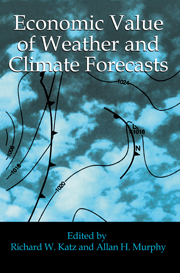5 - Forecast value: descriptive decision studies
Published online by Cambridge University Press: 27 October 2009
Summary
Introduction
Studies of the value of forecasts necessarily consider — either explicitly or implicitly — the decisions made by users of the forecasts. Most such studies involve both description (how users actually decide) and prescription (how they should decide). The purpose of this chapter is to present the descriptive approach to studying the value of weather forecasts and to compare it with the prescriptive approach that is treated in several other chapters of this volume (especially Chapter 4).
Both descriptive and prescriptive approaches are based on the belief that the value of weather forecasts is derived primarily from their effects on the decisions of individuals engaged in weathersensitive activities (McQuigg, 1971), and both approaches require decision-making models to assess those effects. The critical differences between the two approaches are the methods used to develop the decision-making models and the criteria employed for evaluating them. Descriptive models are evaluated according to their ability to reproduce the behavior of decision makers. Prescriptive models are evaluated according to their ability to produce decisions that are optimal according to some normative theory of decision making.
The descriptive and prescriptive approaches are compared in Section 2. In Section 3, a representative sample of descriptive studies is classified and reviewed. Selected results from descriptive research on judgment and decision making that apply to weatherinformation- sensitive decisions are presented in Section 4. Section 5 includes a brief overview of two broad classes of methods for descriptive decision modeling.
Comparison of descriptive and prescriptive studies
In this chapter, the value of forecasts is treated from the perspective of an individual decision maker or a group of decision makers with common interests.
- Type
- Chapter
- Information
- Economic Value of Weather and Climate Forecasts , pp. 147 - 182Publisher: Cambridge University PressPrint publication year: 1997
- 14
- Cited by

